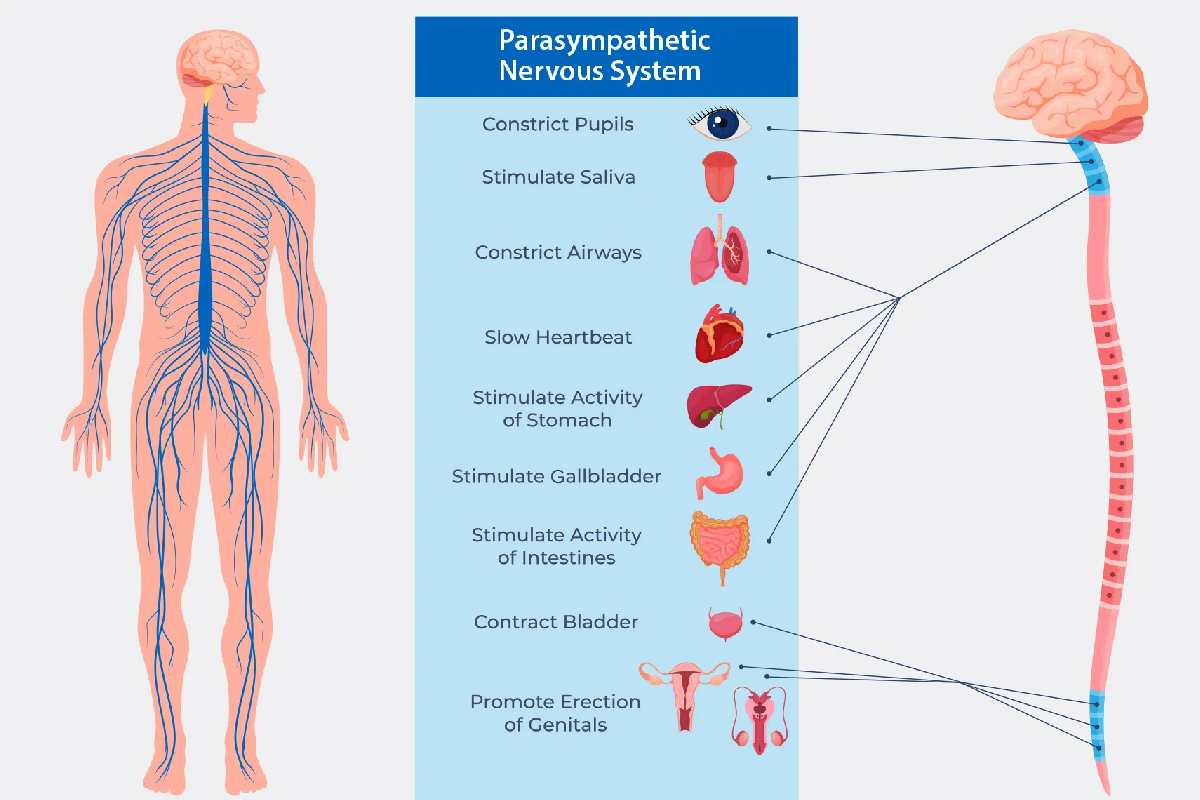Are you familiar with the parasympathetic nervous system (PNS) and how it impacts our mood, health, and everyday life? By the end of this post, you’ll have an excellent grasp of the PNS and three powerful tools to activate it.
Table of Contents
What is the Parasympathetic Nervous System?
To begin, let’s take a deep dive into the PNS. It is part of the autonomic nervous system, which regulates bodily processes like digestion, heart rate, respiration, and more without us having to think about it consciously.
It contains cranial and sacral components responsible for regulating automatic functions like heart rate, respiration, and digestion. In addition, the PNS balances out the fight-or-flight responses from the sympathetic nervous system (SNS).
The main job of the PNS is to restore balance in the body once an activity or event has been completed. This can include activities like physical exertion, stress responses, meal consumption, etc. When the PNS kicks in to bring us back into a state of homeostasis (or balance), it creates feelings of relaxation and calmness throughout our bodies.
It can also help the body heal itself by promoting tissue repair, blood flow, and more. In addition, the PNS works in tandem with the sympathetic nervous system (SNS), which is responsible for arousing us during stressful or exciting events.
Components of the PNS
Next, let’s talk about three primary components of the parasympathetic nervous system: the vagus nerve, the dorsal motor nucleus, and the sacral parasympathetic nucleus.
The vagus nerve
The vagus nerve is the leading player in this system. It runs from the brain stem to several organs throughout the body, providing feedback on their condition to the brain and helping regulate our heart rate and breathing pattern. It also helps control inflammation, digestion, and our mood.
The vagus nerve is renowned for its ability to “switch off” the body’s stress response, which is necessary for restoring balance. So, for example, when we’re running late to work and our stress response kicks in, the vagus nerve helps us return to a calmer state.
Although the stress response can be beneficial when we’re facing an actual threat, chronic stress can have a detrimental effect on our bodies. The vagus nerve helps us stay balanced by calming the body down from this fight-or-flight response.
The dorsal motor nucleus
The dorsal motor nucleus is a collection of neurons located in the brain stem that sends information between the cerebellum (the part of the brain responsible for coordination) and other parts of the body. It helps regulate heart rate and breathing patterns and release hormones like melatonin, cortisol, and oxytocin.
The sacral parasympathetic nucleus
Finally, the sacral parasympathetic nucleus is located near the end of your spine and connects the spinal cord to organs like your bladder, intestines, digestive system, reproductive organs, etc. It helps to stimulate peristalsis (the wave-like movement that helps us digest food) and control the secretion of hormones that affect our digestion, metabolism, sexual arousal, and more.
Activating Your PNS
Now that you have a good understanding of the components of the parasympathetic nervous system, let’s talk about how to activate it.
Here are three simple yet powerful tools you can use to kick your PNS into action:
Deep breathing
Taking long, slow breaths is one of the best ways to relax your body and activate the PNS. When you focus on taking deep breaths, it helps to reduce stress hormones while stimulating the vagus nerve and promoting relaxation.
To begin, start by breathing in deeply through your nose and out through your mouth. As you exhale, imagine the stress leaving your body with each breath. You can also add some visualization techniques like picturing yourself standing in a peaceful mountain valley or lying on a beach to add an extra layer of relaxation.
Yoga
Yoga is another great way to activate the PNS. The combination of physical activity and deep breathing helps to reduce stress and anxiety while stimulating the vagus nerve and improving respiration and blood flow. There are many different styles of yoga, so it’s important to find one that fits your needs best.
Some yoga positions are more beneficial for activating the PNS than others. Try gentle poses like Child’s Pose and Corpse Pose, which help to calm the body and mind while stimulating the vagus nerve.
Vagus nerve stimulation device
Finally, a vagus nerve stimulation device is a small, non-invasive device that can be used to stimulate the vagus nerve, helping to reduce stress and activate the PNS. ApplyingApplying electrical impulses to the neck, scalp, or the ear helps to increase blood flow and release hormones like oxytocin, which can help improve mood.
One option is the Xen by Neuvana vagus nerve-stimulating headphones. Users can wear the headphones and listen to their favorite songs or sounds while the vagus nerve is gently stimulated through the ear. Then, users can experience benefits like a brighter mood, better sleep, and improved digestion.
Other Ways to Stimulate the Vagus Nerve
A VNS device, yoga, and deep breathing are a few other activities that can help stimulate the vagus nerve.
These include:
- Singing or chanting
- Laughing and smiling
- Guided meditation
- Listening to calming music
- Connecting with nature
- Practicing gratitude
Final Thoughts
By using some of these techniques, you can easily activate your parasympathetic nervous system and feel more relaxed and balanced throughout your day. The key is consistency—the more often you practice these activities, the better results you will see! So make sure to add them into your daily routine for maximum benefit. With regular practice, activating your PNS should become second nature in no time.

